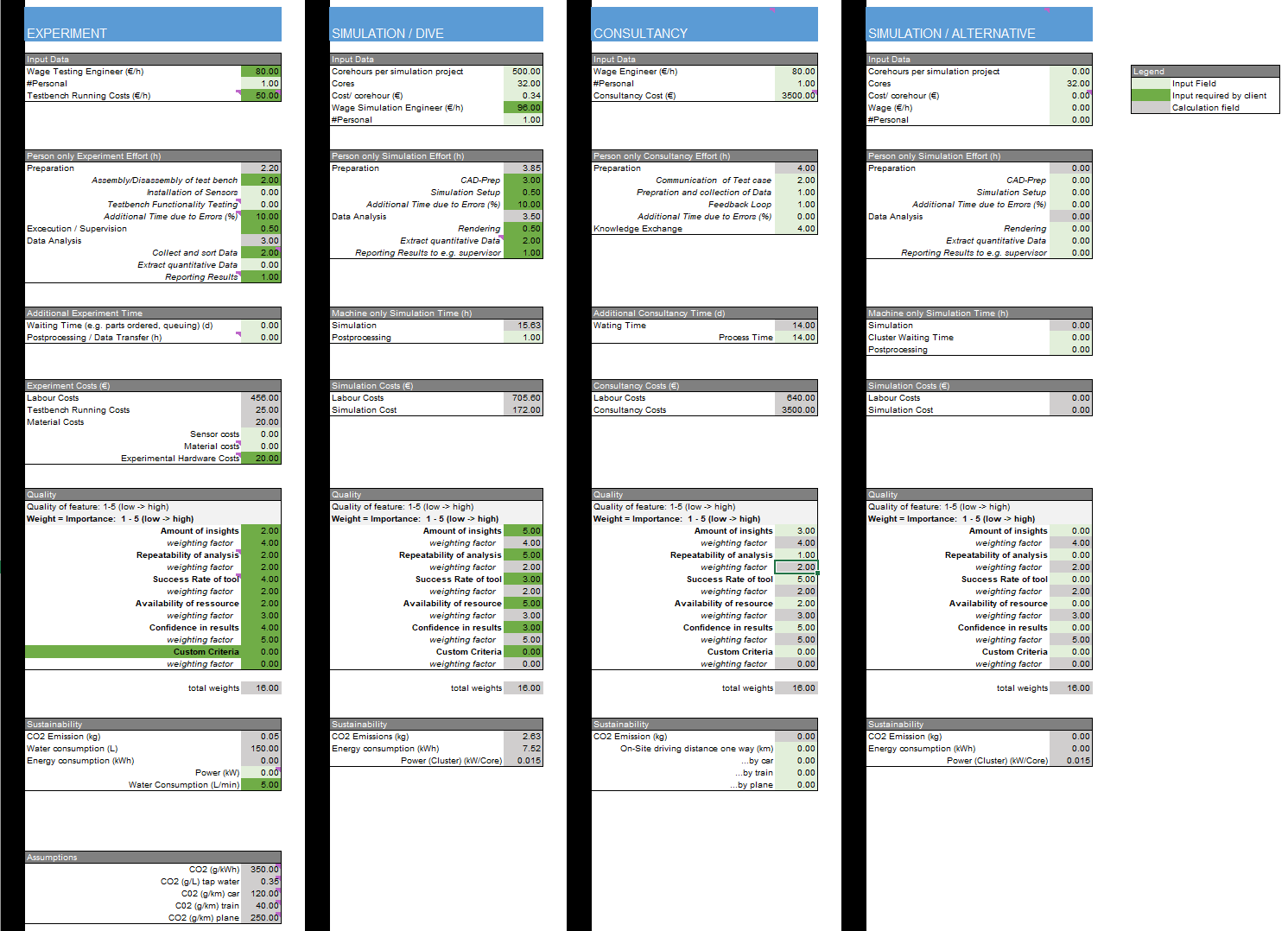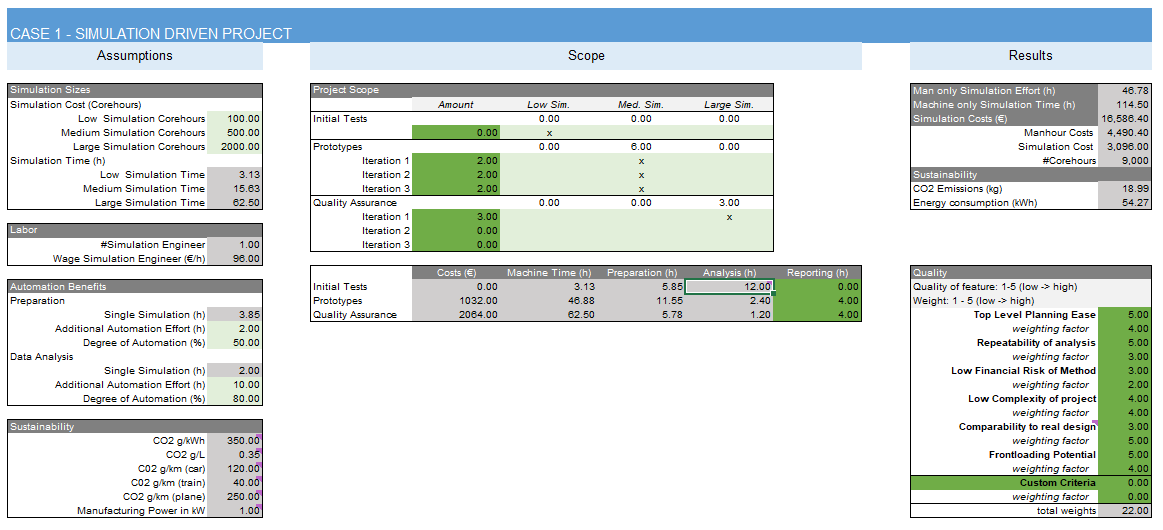
How to Write a Business Case for CAE Software
A Complete Guide and Business Case Template for Design Engineers Who Need CAE Software
As a design engineer, you know your company is ready to invest in a new software to optimize the product development workflow and you are tasked with the job of deciding which tool best fits your company’s needs. To convince decision-makers of your choice, you must present a compelling business case which supports your decision as a solution to a problem and provides justification for this new investment.
In this article, you will learn the definition of a business case, why it is important in the context of investing in a CAE software, key components to consider when evaluating if CAE is the right option for your organization, and which type of simulation software best suits your needs. We also provide a downloadable business case template which you can use when evaluating your options for optimizing your engineering design process.
Why Have a Business Case for CAE Software?
Design engineers are pressed to innovate their products because of the competitive pressure to differentiate their products with better quality, reliability, or richer functionality. Though development resources are limited, products are becoming more complex or must operate in extreme environments. This pressure requires design engineers to reconsider traditional methods for testing and analyzing their designs.
CAE tools are one such option which is becoming more attractive due to the many ways in which they can save engineers’ time and resources. The following data from Aberdeen Strategy & Research presents some of the reasons design engineers are choosing to use CAE tools to improve their workflows.

The earlier simulation is implemented within the design process, the more a project can benefit from these high-quality virtual insights. This so-called front loading process is the holy grail in product development. It is well known that design change costs increase tenfold per step the later the failure is detected in the product lifecycle.

Unfortunately, simulations are often outsourced and design engineers currently outnumber simulation experts 10-to-1. The simulation specialist group is likely to become the bottleneck in the design process. To circumvent this issue and achieve simulation-driven design, design engineers should start to apply CAE early in the design process themselves with customized and automated simulation workflows made available to non-experts.
What Is a Business Case?
Whether you are trying to sell someone your software or convince your boss to move to an office with a rooftop pool, a well-constructed business case is a critical tool for presenting your reasonings and conclusions to decision-makers. A business case is used to justify a proposed project that requires some type of capital or operational expenditure. To push your decision through the pipeline in the given examples, you need validated assumptions on how this software drastically reduces development costs or statistics on how rooftop pools attract best in class candidates. Your case should underline the benefits of your proposed solution while putting multiple options into perspective to address the company or individual’s needs and opportunities.
The Magic Triangle
In project management, a business case is most often used as a living document for continually assessing and evaluating the progress of the initiative. In this context, a well-known approach is the “Magic Triangle” which highlights the dependencies of three dimensions: time, quality, and cost.
The time dimension concerns the duration of the process and is highly important when prioritizing a quick time to market for a new product, though decisions made for this purpose often require additional financial resources and may sacrifice product longevity to meet strict deadlines.
The quality dimension defines the tasks and goals which must be completed and fulfilled by the end of the project. Staffing a large and highly skilled office for recruitment purposes means you prioritize building the highest quality team while accepting higher costs associated with this decision.
It goes without saying that the cost dimension is always considered and needs no further explanation. As we can see, these three dimensions are unavoidably in conflict and finding a balance is key when setting priorities and reaching a compromise.

The Magic Square
Nowadays, the magic triangle is shifting towards a square, with the addition of a sustainability factor. Given the growing importance of environmental concerns, companies are now considering the impact their products make on the world in a holistic and long-term sense. This is driven organically by the company’s vision or inorganically by the governmental regulations. Sustainability-focused changes made within an organization can range in scale from refusing to print documents and signing digitally, to installing solar panels on top of a manufacturing hall.

The Business Case for CAE Software
Even if you are already interested in investing in CAE software, it is important to evaluate all possible solutions for optimizing the testing process and frame your business case as a problem needing a solution and conclude with a recommendation. This means that we must analyze and consider all options, including experiments, both cloud-based and on-premises CAE software, and outsourcing simulation to a consultancy.

Experiment

Traditionally, most engineers consider test benches (experiments) to be the single point of truth when it comes to modelling the real application. This might be the case because the test rig looks and operates like the real application. Still, one might be biased, as systems that look similar might not behave similarly under real operating conditions and difficulties can arise from areas not checked in the prototype. Let’s consolidate some advantages and disadvantages here.
Advantages:
- If the operating conditions are well-known, one can reproduce those in a real test aperture with high accuracy.
- Typically, it is easier to measure “normal” operating conditions longer than one could simulate them.
- Current measurement tools are likely to capture both integrated and sometimes all the local quantities of interest with high temporal resolution and low overall uncertainty if installed and operated correctly. Methods like Particle Image Velocimetry (PIV) allow for the resolution of the three-dimensional fluid field in gearboxes from visual data.
- Repeated measurements give an idea of the volatility of the experiment which is typically not provided by the simulation.
Disadvantages:
- Investigating edge cases is likely to result in damages or even safety risks.
- The initial prototype will be expensive, as the tools and processes do not yet exist.
- Visual or intrusive access to the “inside” of the machine for sensors or visual observations is required which might even affect the measurement conditions. Once again, this increases the manufacturing difficulty.
- Manufacturing processes like casting or milling consume a high amount of energy, which should be considered in the sustainability dimension. However, the exact impact is difficult to assess and would require an excel sheet of its own.
- Running a test bench uses resources like energy and water for cooling or lubricant, which must also be considered in terms of sustainability. For large and powerful products, e.g., in heavy-duty or wind power applications, these costs can be significant, which is why most design engineers in these fields tend to avoid experimental testing as much as possible.
- Post-processing effort is required to extract quantitative results and create reports. Especially for long measurements with high temporal resolution, a solid understanding of uncertainty analysis and statistics is required for high fidelity predictions.
- A test-rig is typically located in an additional laboratory. The measurement equipment must be calibrated, certified, and replaced. These are sources of additional running costs.
- The time and cost dimensions of developing and operating a whole test rig for the purpose of investigating different prototypes can easily take a few years and typically involves academic partners if more than a standard solution is desired.
- The test-rig usually comes with a bad environmental footprint when the application is large-scale due to extraordinary power demands and the large amount of testing equipment and expendable goods required.
On-Premises Simulation

CAE is already an established method within the mechanical and automotive industry. Currently, on-premises CAE solutions are the standard in enterprise companies. Software packages are bought once, some service packages are added, and updates are implemented whenever necessary. The software is installed locally and integrated into a company’s IT. Similarly, the in-house IT department manages simulation data and software versioning and hardware compatibility.
Advantages:
- CAE allows for the possibility to evaluate all spaces inside of a machine.
- Since the software is locally deployed, testing on your own machine is straightforward.
- If one manages to always run a cluster at 100% utilization, it may be more affordable than cloud-based solution.
- Automation and parallelization are also possible, but the latter depends on the capacity of the cluster. This may reduce human interaction, along with the risk of failure, time, and cost. Automation routines and workflows allow one to “copy paste” a lot of work, reducing pre- and post-processing effort.
Disavantages:
- The software is only installed at certain workstations and therefore is only accessible on certain machines by the simulation expert group.
- The IT department is responsible for installing and regularly updating the CAE software as well as maintaining the HPC cluster. This results in overhead which should be considered when evaluating CAE at an entire business level. Bear in mind that the facility and electricity costs of the cluster can account for 30% of the total cost of ownership (TCO), which is defined as the purchase price of an asset plus all operating costs over its lifespan. Have a look in our cloud computing article where you will find an example TCO of a 256 core HPC system.
- Having a larger buffer to run simulations in parallel at peak load usually results in lower utilization and thus increased cost per core-hour of the cluster.
- Collaboration is difficult and costly. Additional overhead could occur due to collaboration within the simulation group. Data transfer between workstations influences the time and cost dimensions from a business level viewpoint. Remote work is expected to remain at a high level following the Covid-19 pandemic, increasing the importance of collaboration across distances.
- There is an IT security concern when downloading & uploading sensitive data from a home computer or USB drive.
- There is a financial risk due to the large upfront investment and usually late ROI of the hardware resources.
- Person-hours are required for preprocessing to simplify the CAD geometry and create the simulation setup, as well as post-processing.
Cloud-Based Simulation (SaaS)

In Software-as-a-service (SaaS) simulation tools the user pays to access the software on yearly subscription basis. The software is completely owned, delivered, and managed in the cloud by a third party.
Advantages:
- There is the possibility to evaluate all spaces inside of a machine.
- The total cost of ownership (TCO) is reduced.
- You can more easily monitor your running costs.
- Automated workflows can be easily established, reducing human interaction along with the risk of failure, time, and cost.
- All simulations can be run in parallel, speeding up the time to result regardless of how many computing instances are used. As this model does not rely on local computing clusters, there is no bottleneck in hardware availability.
- Streamline collaboration between design and simulation teams. As tools are accessible through a web-interface, users can work simultaneously, and results are easily shared and accessible to everyone.
- As the software is accessible from every notebook with internet connection, the cloud will allow you to get rid of all larger workstations and cluster instances. This makes your internal IT hardware overhead smaller and offers easy solutions for remote work. In addition, this is by far the fastest way to just get started investigating your complex engineering project.
- There is no need to update and maintain the software, which would usually be handled by the IT department. Simulations are always executed on the most up-to-date cloud computing hardware.
Disadvantages:
- Person-hours are required for preprocessing to simplify the CAD geometry and create the simulation setup.
- While the calculation in the cloud is purely a waiting game, the post-processing may require significant human effort to create visualizations and extract quantitative data.
- Typically, security concerns exist for cloud-based solutions as the data is stored decentralized. However, according to an article by Gartner 99% of security failures in 2025 are expected to be caused by the user and not the cloud provider.10
- An active internet connection is required to utilize the simulation service.
- If required, downloading large simulation data for archiving purposes can take a lot of time.
- One way or the other, reserving the required computing resources or offsetting it after the project can become time-consuming if no specialized tracking system is installed.
- Integrating the cloud solution with existing processes is likely to be more tedious as data must be imported/exported to an outside service.
- As the whole workflow is optimized for the cloud, one may get into a vendor and price lock.
- Psychologically, you feel charged for every simulation that you execute and seeing your paid computing hours decrease while simulating can feel uncomfortable at first.
Outsourcing Simulation to a Consultant

Outsourcing simulation and engaging a consultancy is another option. This approach is not only used by SME’s but also by large OEM’s. Considering all the different expenditures we mentioned from hardware to IT staff, assigning a consultancy to these tasks and paying a fixed price for the results can be quite a convenient alternative. If the simulation demand is rather low, SMEs tend to favor this option. However, the decision will greatly depend on the business case, since having 2-3 simulation projects a year may already be worth doing simulations on-site. Most importantly, one must take care that the insights gained through the simulation satisfy the company’s needs.
Advantages:
- If you encounter one simulation problem per year it is probably cheaper to outsource this task.
- If your staff is not trained in simulation software and you don’t have any capacities to train them, outsourcing simulation tasks is the only viable option. Some simulation questions are too difficult to be answered by your internal experts or require the usage of additional and more specialized tools. Consultants are the experts of the experts for specific simulation tools and their applications.
- If you are running low on internal capacities, outsourcing simulations is an attractive solution to free internal resources.
Disadvantages:
- The price per simulation is high. As a rule of thumb, low effort CFD simulations cost low 4 digits, high effort simulation cost more than 5,000€ and particularly difficult simulations can easily reach several tens of thousands of euros.
- Finding the best consultancy solution for your problem, receiving offers, and communicating and iterating over the results together with them is a time-consuming process and may span over several weeks.
- You only receive the data you requested or what has been negotiated in the contract, which makes future investigations into this simulation difficult.
- Typically, you do not build internal knowledge about the capabilities and limitations of the simulation software and the simulation problem itself. It is difficult to understand what was easy versus what was challenging when setting up, conducting, and evaluating the simulation. In fact, the simulation itself turns into a black box for you. Generally, the detailed knowledge lies outside of the company, and one gets only the documented results within a PowerPoint.
- Giving your data to external contractors also creates security risks for your precious know-how.
Your Business Case Template
To help you build your business case, we have provided you with a free excel business case template.
Like all business cases, the document starts with some general information, the situation analysis, and an executive summary. It makes sense to start with the simplest evaluation of the dimensions of time, cost, quality, and sustainability of the different CAE options regarding a single simulation. This means that we must also consider the option of not using CAE and instead conducting just one experiment. Although filling in the data on this level already allows for comparison, it is necessary to go deeper to see the bigger picture.

The next step is to investigate the data on a project level. This could be the optimization of an existing product or the development of a new design. This step involves performing multiple simulations or experiments to validate a variety of operating points or conduct design iterations. On this level, the automation of workflows and parallelization of simulations kick in. We suddenly are in the range of months, several tens of thousands of euros, and in the kg-range of CO₂ emissions. This is when things get exciting when comparing the edge cases, fully experimental or simulation-driven design, and one might begin to grasp the potential of CAE.

This data will serve as a fundamental baseline for optimizing your mix of CAE and experimental work in practice. In the last step, additional factors are considered to tell the full story from a company level perspective, as other stakeholders, such as the IT department, are included and the ROI of the CAE tool is estimated.
Conclusion
We hope that you were able to take away some tips and tools about how to build a business case as you take the time to evaluate your options for optimizing your product design process. Feel free to get in touch and let us know if you have any questions about any of the points mentioned above or would like to learn more about how to write a business case for CAE software.




